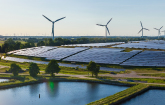DUBLIN, Jan. 22, 2023 /PRNewswire/ -- The "European Residential Solar Market: Analysis By Accumulated Installation, By Accumulated Capacity, By Region Size and Trends with Impact of COVID-19 and Forecast up to 2027" report has been added to ResearchAndMarkets.com's offering.
The European residential solar market, on the basis of accumulated capacity, is anticipated to grow at a CAGR of 9.60% over the projected period of 2022-2027.
The European residential solar market, in terms of accumulated capacity, in 2021 stood at 40.40GW, and is likely to reach 71.75GW by 2027. A residential solar PV system is any solar PV system that produces less power than or equal to 250kW. A typical 65 by 39-inch residential solar panel installation contains 72 cells.
The use of non-renewable fuels and other types of energy resources is posing major dangers to the ecosystem, making solar power more important than ever. The use of solar energy has increased dramatically in recent years in both developed and developing countries.
Solar energy is currently one of the most affordable and widely available renewable energy sources for European households. By 2040, it may be able to supply up to 20% of the EU's electricity needs based on current market trends. The expansion of residential solar energy installations is a crucial step in the transition to clean energy and climate neutrality.
Market Segmentation Analysis:
By Accumulated Installation: On the basis of accumulated installation, the European residential solar market can be divided into five major regions: Germany, Netherlands, Italy, Spain, and Rest of Europe. Germany is the largest solar market in Europe as well as the largest solar PV operator in 2021, owing to the German government's implementation of a subsidy for residential installations of solar PV panels with battery storage in 2016.
By Accumulated Capacity: The European residential solar market can be divided into nine primary regions based on accumulated capacity: Germany, Netherlands, Italy, Poland, Belgium, the UK, Sweden, Spain, and the Rest of Europe. Due to the removal of the Sun tax on self-consumption in 2020, automated excess recompense, as well as collective and through-the-network facilities, the Spanish residential solar market is believed to be the fastest growing market. Since then, the market for final consumers has steadily gained traction.
European Residential Solar Market Dynamics:
Growth Drivers: As a result of a large drop in price, solar energy is becoming economically viable at smaller scales and at more locations. People in Europe are spending more on the installation of solar power systems as the cost of solar energy continues to decline. Further, the market is expected to grow owing to surging demand for electrification in society, higher and more volatile electricity prices, increased support from government, etc. in recent years.
Challenges: The European residential solar market's supply chain has become more clogged, with inefficiencies in hardware delivery. Many countries have experienced a labor shortage in recent years, owing to mismatches between supply and demand. As a result, customers' residential solar power systems appear to take longer to install after they are ordered. Hence, the residential solar market in Europe has faced long-term value chain disruption.
Market Trends: The payback period for residential solar has decreased, even though this varies greatly from country to country due to various sun conditions and deployment rules. The alternative cost of using the grid instead of installing residential solar is also decreasing as a result of positive market dynamics in the Europe. Despite major differences, all countries' payback periods are far less than the solar panels' 30+ year anticipated lifetime.
Therefore, short payback time for residential solar in Europe is likely to upgrow the overall market, in coming years. More trends in the market are believed to grow the residential solar market during the forecasted period, which may include use of artificial intelligence, European solar rooftops initiative, national energy and climate plans (NECPs), etc.
Competitive Landscape and Recent Developments:
A large number of installation businesses make up the highly fragmented residential solar market in Europe, owing to the availability of local, regional, and multinational suppliers.
While some smaller businesses specialize in selling solar panels and are only present in one or a few places, larger businesses often offer a wider range of products, have a larger geographic presence, and strive for continued expansion. In the residential solar sector, where businesses sell or lease products with lengthy lifetimes, scalability and the capacity to rapidly increase market share are key determinants.
Moreover, some of the major drivers that can propel the industry's growth are fierce rivalry, rapid technology advancements, frequent changes in governmental policy, and tight environmental laws. Cost, product quality, dependability, and aftermarket support are all domains where vendors compete. In a highly competitive market environment, providers must offer affordable and effective products to thrive.
With investment budgeted, factories planned, environmental targets established, and governmental strategies outlined to support the predicted expansion of PV systems, ambitious measures are in place to restart a thriving industry.
For example, In October 2021, Meyer Burger Technology AG, a Switzerland-based solar module maker, unveiled a building-integrated PV (BIPV) project regarding solar roof tiles. The new product was designed by a German engineering company paXos Consulting & Engineering GmbH & Co. KG and sold the patent to Meyer Burger.
Market Dynamics
Growth Driver
- Decline in the Cost of Solar Power
- Surging Demand for Electrification in Society
- Higher and More Volatile Electricity Prices
- Increased Support from Government
Challenges
- Value-chain Disruption
Market Trends
- Use of Artificial Intelligence
- Short Payback Time for Residential Solar in Europe
- European Solar Rooftops Initiative
- National Energy and Climate Plans (NECPs)
Further, key players in the European residential solar market are:
- Otovo ASA
- Columbus Energy SA
- Zonneplan
- Enpal GmbH
- SolarNRG
- Engie SA (Sungevity Europe)
- AutoBinck Group (Zelfstroom)
- Koolen Industries (BonGo Solar)
- Svea Solar
- Zolar Gmbh
- DZ-4 GmbH
- Victron Energy
- Hanwha Group (Hanwha Qcells)
- Luxor Solar GmbH
European Market Analysis
European Solar PV Market: An Analysis
European Solar PV Market: An Overview
- European Solar PV Market by Accumulated Capacity
- European Solar PV Market by Solar Capacity Per Capita
- EU Countries Solar PV Market by Penetration
European Solar PV Market Accumulated Capacity by Segment
- European Residential Solar Market: An Analysis
- European Residential Solar Market: An Overview
- European Residential Solar Market by Accumulated Installation
- European Residential Solar Market by Accumulated Capacity
- European Residential Solar Market by Region (Germany, the Netherlands, Italy, Poland, Belgium, the UK, Sweden, Spain, and the rest of Europe)
For more information about this report visit https://www.researchandmarkets.com/r/mewkr4
About ResearchAndMarkets.com
ResearchAndMarkets.com is the world's leading source for international market research reports and market data. We provide you with the latest data on international and regional markets, key industries, the top companies, new products and the latest trends.
Media Contact: Laura Wood | +353-1-481-1716 | [email protected]
Logo: https://mma.prnewswire.com/media/539438/Research_and_Markets_Logo.jpg
SOURCE Research and Markets

WANT YOUR COMPANY'S NEWS FEATURED ON PRNEWSWIRE.COM?
Newsrooms &
Influencers
Digital Media
Outlets
Journalists
Opted In





Share this article